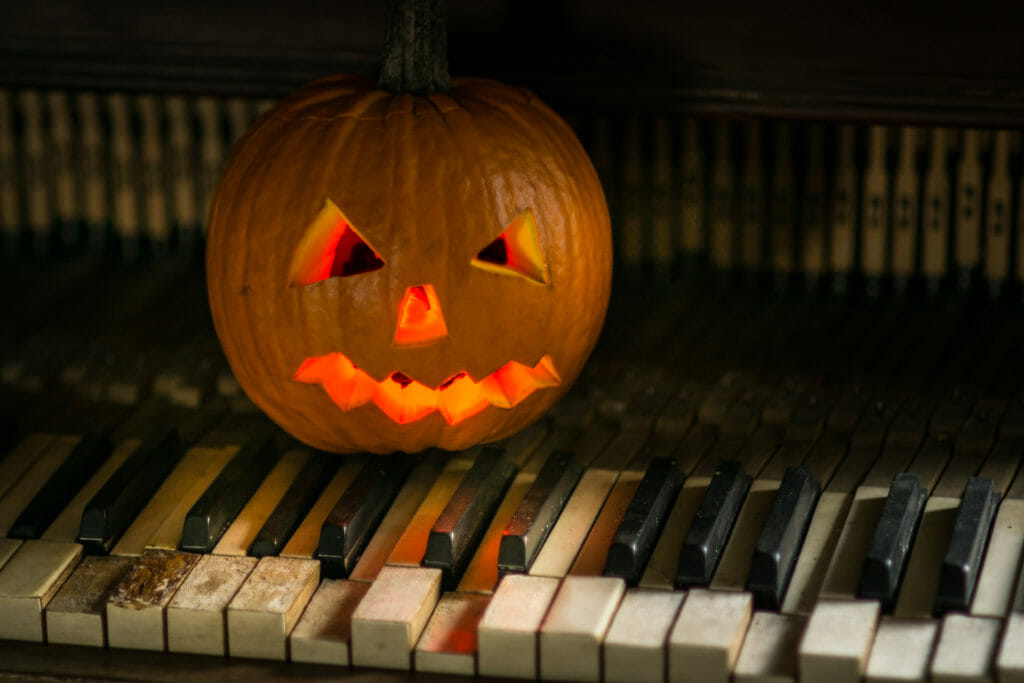I believe that Ira Gershwin said it best: “How strange the change/from major to minor.” It’s strange, indeed. Whether you realize it or not, I know you’ve heard it before: the creepy minor key.
From the traditional sounds of a pipe organ (at a haunted house, perhaps):
To eerie creepy music boxes:
We could spend ages talking about the theory behind mode, minor key songs that are actually joyful-sounding, and the debate on whether or not it’s a biological response or solely the result of how Western musical culture dictates how our ear perceives the minor key… but it’s already Halloween, and you don’t have much time (cue door slamming and tick-tocking of clock).
If you want to know about how to summon the spirit of All Hallow’s Eve in your own music (or just how to make some poppy bubblegum song turn dreary), then read on.
Simply put, the minor key is often synonymous with:
- Sadness
- Negativity
- Something going wrong, terribly wrong
- Frightening
But why?
The Science Behind the Creep Factor
 According to Dr. Vicky Williamson, lecturer in Music Psychology at Goldsmiths University, we are culturally conditioned to perceive major key music as happy and minor key music as… not. She writes, “Constantly touching base with our musical memory back catalogue helps to generate expectations of what might come next in a tune, which is an important source of enjoyment in musical listening.”
According to Dr. Vicky Williamson, lecturer in Music Psychology at Goldsmiths University, we are culturally conditioned to perceive major key music as happy and minor key music as… not. She writes, “Constantly touching base with our musical memory back catalogue helps to generate expectations of what might come next in a tune, which is an important source of enjoyment in musical listening.”
However, new evidence has emerged, indicating that we may be wired to listen for sadness in the minor key after all. Meagan Curtis of Tufts University’s Music Cognition Lab led a study whose results study revealed that the relationship between pitches serves as an important cue for conveying emotion in music. The musical interval referred to as the minor third is generally thought to convey sadness, and that minor third also occurs in the pitch contour of speech conveying sadness. Her findings support the theory that human vocal expressions and music share an acoustic code for communicating sadness.
Yet another study suggests that there is a connection between horror music and the screeches of young frightened animals. Such nonlinear sounds – a dissonant chord, a child’s cry, a baby animal’s scream – trigger a biologically-ingrained response by making us think our young are threatened, according to Blumstein’s study, sponsored by the University of California at Los Angeles and published in the journal Biology Letters.
Take A Listen
It doesn’t matter whether you subscribe to the nature or the nurture theory: when a happy song takes on a minor key, the sound summons a bit of the sinister. Check these out:
1. Hey Jude
This cover by Tyler Ward & KHS takes a sad song and makes it sadder:
2. Blackbird
The most mournful take on Blackbird ever, thanks to Major to Minor’s Chase Holfelder, the true master of tampering with otherwise happy tunes and bringing them all down a notch… or a million:
3. Wrecking Ball
Instrumentation and the minor key implementation bring on the frightening ghoulishness. You can just see the mascara running everywhere and the revenge-filled girlfriend making this a demented theme song:
4. YMCA
This new approach to YMCA carries the feeling of dread and warning in the introduction:
5. Imagine
The totally depressing and supremely pessimistic take on imagining the future ahead:
Fathoming Minor
So how can you begin to create your own creepiness and unease? To begin with, we must understand what constitutes a minor key. Essentially, we know if a song uses a minor key by seeing if it’s using a minor scale. The pattern of a minor scale takes the following steps up from the starting note (also known as the base note or tonic note). It goes a little something like this:
Whole-Half-Whole-Whole-Half-Whole-Whole
For example, if you wanted to turn a regular A major scale into a something a bit more, shall we say, haunting, simply follow the pattern of whole-half-whole-whole-half-whole-whole up the scale and back. You’d end up playing (starting from A, remember): A-B-C-E-D-F-G-A. And there’s your minor scale.
Now would be a good time to point out that major keys share the same key signature with their relative minor keys – in this example, A minor shares the same key signature of having zero sharps or flats with C major. Because they share something in common – musical DNA, so to speak – the minor is a relative to the major, hence the name relative minor.
If you want to use a major key to find the relative minor key, just find the name of the major key and move three half-steps backwards (or down). Three half-steps down from C is A, so A is the relative minor of C major. And that, boys and ghouls, is knowledge, and knowledge found here is musical power.
Spookifying A Major Key
Now that we’re familiar with the relationship between major and minor, let’s use the example of cousins C major and A minor to see how we can go from a cheery major to a foreboding minor.
1. To turn a C major into a song evoking a sad or melancholy, wistful feeling, sub in the 1-4-5 chords from C major with 1-4-5 chords from A minor.
Instead of this:
C – F – G
(I – IV – V)
Use this:
Am – Dm – Em
(i – iv – v)
2. To bring an even spookier feel to an A minor song, use the following chord progression: i – ii dim V – i.
Example: Am – Bdim – E – Am
For more exercises in creating your own minor chord progressions, head over to this guide to discovering more minor chord progressions.
Build-Your-Own Creepy Tune
Armed with some minor key theory and emboldened by the spirit of Halloween, you are now ready to take on the sacred task of writing your own frightening magnum opus.
- Use a minor key (see above and be sure to reference the related links for more in-depth info and cheat sheets).
- Consider your tempo. What kind of effect will increasing or decreasing the tempo have on your song? Play around with it and see what gives you the effect you’re after.
- Determine your instrumentation. A song can sound totally different when you play it in a minor key on a xylophone or harpsichord. If you have access to a keyboard (or hey, said harpsichord), you can use different sounds to heighten the dreadful vibe. Try:

- Strings
- Tuba
- Oboe
- Chimes/xylophone/music-box instruments
- Organ
- Piano
- harp/harpsichord
- Bass guitar
- The waterphone
- Theremin
- Pipe organ
- Ondes martenot
- Blaster beam
Embracing the Macabre
If this was your first taste of the world of the spooky minor… welcome! There’s a bottomless hole of possible chord progressions, melodies, and modalities to add the scare factor to your music.
If you want to delve further into the world of minor, be sure to check out the aptly named The Ultimate Guide to Minor Keys. For a lesson on the minor modes and how to use them, head over to The Many Moods of Musical Modes to further expand your minor vocabulary.
As we celebrate the faithful departed and embrace the darker months ahead, there’s no better time to explore the sad, frightening, and tense side of music. Happy Halloween!
The relationship between major and minor is an inverse, complementary one – switching between the two in the course of a single song is an excellent way to keep your listener engaged – so experiment with incorporating minor into your cheery tunes, and take your audience on an emotional rollercoaster!
The post The Creepy Minor Key appeared first on Musical U.